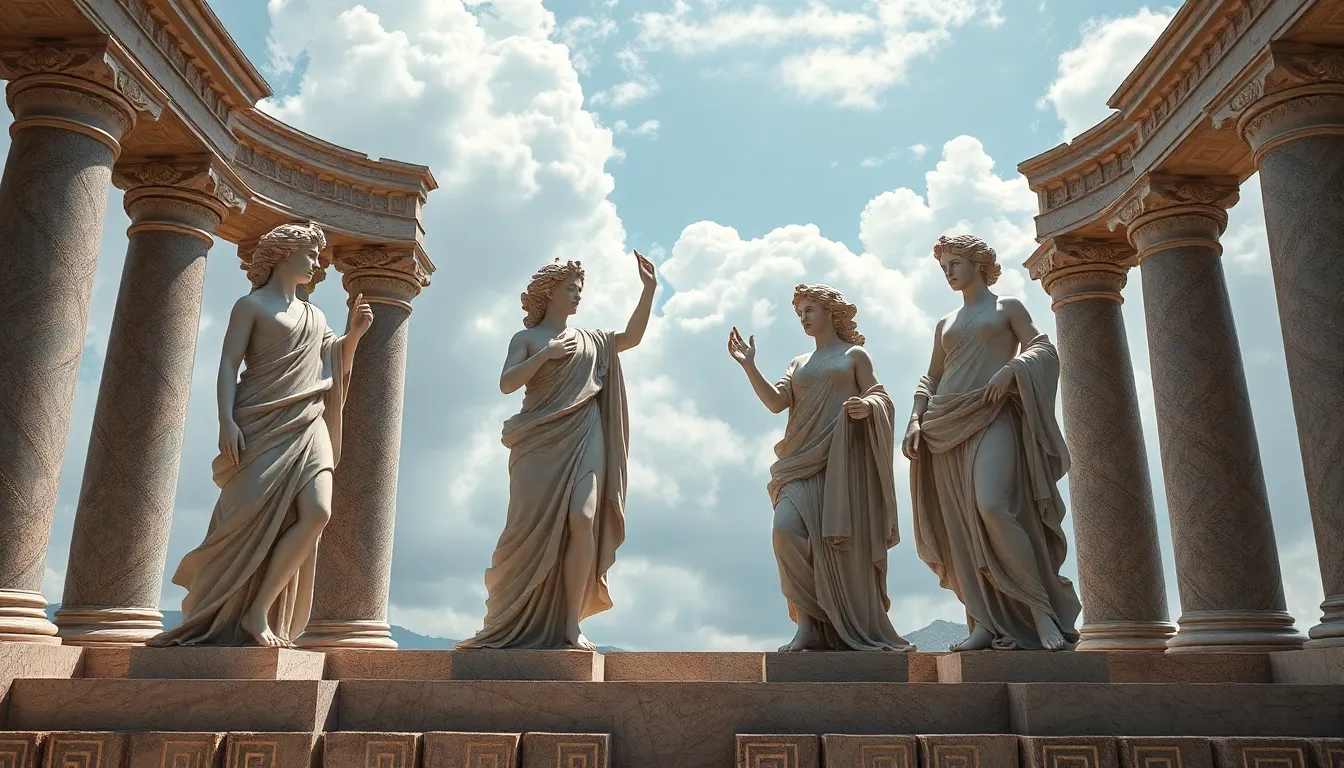The Muses and Their Role in the Evolution of Theatre
I. Introduction
The Muses, in Greek mythology, are the goddesses of inspiration in the arts and sciences. They are often depicted as beautiful young women, each representing a different domain of the creative process. The significance of the Muses extends beyond mere inspiration; they embody the very essence of artistic expression and creativity, providing guidance to artists, poets, and playwrights.
This article explores the profound influence of the Muses on the arts, particularly theatre, and their enduring legacy in shaping the evolution of theatrical forms. By examining the historical context of the Muses, their specific contributions to theatre, and their representation throughout different periods, we can better understand their crucial role in the development of this art form.
II. Historical Context of the Muses
The concept of the Muses originated in ancient Greece, where they were revered as divine sources of inspiration. Traditionally, they were thought to be the daughters of Zeus and Mnemosyne, the goddess of memory. Each Muse had her own unique domain, which allowed artists to seek inspiration tailored to their needs.
The Muses served as symbols of inspiration, motivating countless artists and playwrights to pursue their craft. In a society that placed a high value on storytelling and performance, the Muses represented the ideal of creative excellence, encouraging the pursuit of knowledge and artistic mastery.
The cultural impact of the Muses on ancient Greek society cannot be overstated. They were celebrated in poetry, music, and drama, and their influence permeated various aspects of life, from education to religious practices. Festivals dedicated to the Muses were common, and many artists invoked their names in hopes of gaining favor and inspiration.
III. The Nine Muses and Their Specific Contributions to Theatre
The Muses comprise nine distinct figures, each contributing uniquely to the realm of theatre:
- Calliope: The Muse of epic poetry, she influenced the narrative structures of theatre, shaping grand stories that captivated audiences.
- Clio: The Muse of history, her presence in theatre is evident in plays that draw on historical events and figures, enriching dramatic narratives.
- Melpomene: The Muse of tragedy, she embodies the emotional depth that characterizes tragic plays, allowing audiences to connect with profound human experiences.
- Thalia: The Muse of comedy, she inspires humor and wit in theatrical works, contributing to the evolution of comedic forms and styles.
- Terpsichore: The Muse of dance, her influence is seen in the integration of movement and choreography into theatrical productions, enhancing visual storytelling.
- Erato: The Muse of love poetry, she impacts romantic themes in plays, offering depth to character relationships and emotional arcs.
- Polyhymnia: The Muse of sacred poetry, her contribution is significant in religious theatre, where themes of spirituality and devotion are explored.
- Urania: The Muse of astronomy, she provides metaphorical implications in theatre, encouraging explorations of the cosmos and human existence.
IV. The Muses in Ancient Greek Theatre
The Muses were not just abstract concepts; they were actively represented in plays and performances of ancient Greece. Often, playwrights would invoke the Muses at the beginning of their works, seeking their blessing for creativity and inspiration.
The role of the Muses was particularly prominent during festivals such as the Dionysia, where dramatic competitions took place. Playwrights like Aeschylus, Sophocles, and Euripides were known to honor the Muses through their works, which often contained themes of fate, love, and the human condition.
Case studies of notable playwrights reveal how the Muses influenced their writing:
- Aeschylus: Often referred to as the father of tragedy, he incorporated themes inspired by Melpomene in his works.
- Aristophanes: A master of comedy, he drew heavily from Thalia, using humor to critique society and politics.
- Sophocles: His tragedies often invoked Clio, weaving historical context into his narratives.
V. The Muses in the Renaissance and Beyond
The Renaissance marked a revival of classical themes and the Muses, deeply influencing theatre during this period. Playwrights sought to rediscover and reinterpret the works of ancient Greece and Rome, often integrating Muses into their narratives.
Notable playwrights of the Renaissance, such as Shakespeare and Marlowe, were inspired by the Muses in their storytelling. They embraced the archetypes represented by the Muses, leading to the transformation of theatrical styles and genres, from grand tragedies to intricate comedies.
The evolution of theatrical forms during this time can be attributed to:
- The blending of genres, where tragic elements were infused into comedies, reflecting the emotional range of the Muses.
- The incorporation of music and dance, inspired by Terpsichore, enhancing the overall theatrical experience.
- The exploration of human emotions and relationships, particularly influenced by Erato and Melpomene.
VI. The Muses in Modern Theatre
Contemporary interpretations of the Muses in theatre continue to be relevant. Modern playwrights and performers often draw upon the rich legacy of the Muses, exploring their themes in new and innovative ways.
The ongoing relevance of the Muses is evident in various forms of modern storytelling and performance, including:
- Musicals that blend narrative and song, often invoking Terpsichore.
- Plays that tackle historical themes, echoing Clio’s influence.
- Contemporary tragedies that delve into emotional experiences, reminiscent of Melpomene.
VII. The Muses as Archetypes in Theatre
The Muses serve as archetypal characters in various forms of theatre, resonating on psychological and emotional levels. They embody universal themes of creativity, inspiration, and the human experience, allowing for rich character development and plot structures.
The psychological resonance of the Muses in performances can be seen in:
- Their embodiment of the creative struggle, reflecting the inner conflicts faced by artists.
- Their representation of dualities, such as tragedy and comedy, allowing for complex character arcs.
- Their influence on thematic exploration, encouraging playwrights to engage with profound questions of existence.




